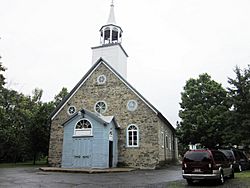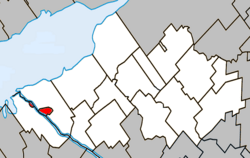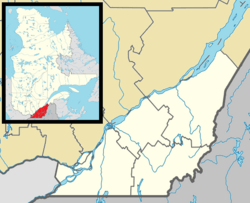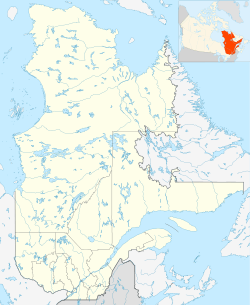Odanak facts for kids
Quick facts for kids
Odanak
|
|
|---|---|

Saint-François-de-Sales church
|
|

Location within Nicolet-Yamaska RCM
|
|
| Country | |
| Province | |
| Region | Centre-du-Québec |
| RCM | None |
| Constituted | unspecified |
| Government | |
| • Type | Band council |
| Area | |
| • Total | 5.70 km2 (2.20 sq mi) |
| • Land | 5.61 km2 (2.17 sq mi) |
| Population
(2021)
|
|
| • Total | 481 |
| • Density | 85.8/km2 (222/sq mi) |
| • Dwellings | 243 |
| Time zone | UTC−5 (EST) |
| • Summer (DST) | UTC−4 (EDT) |
| Area code(s) | 450 |
| Access Routes | |
Odanak is a special place called a First Nations reserve. It is home to the Abenaki people in the Central Quebec area of Quebec, Canada. In 2021, about 481 people lived there.
The reserve is located where the Saint-François River meets the big St. Lawrence River. It is close to the town of Pierreville. The name Odanak comes from the Abenaki language. It means "in the village."
Contents
History of Odanak
Early Inhabitants of the St. Lawrence River Valley
Around 1000 CE, people who spoke Iroquoian languages lived along the St. Lawrence River. They grew crops and also hunted and fished. By 1300, they built strong, walled villages. These villages were like the ones French explorer Jacques Cartier saw in the mid-1500s. He visited places like Hochelaga and Stadacona.
However, by 1600, these villages and their people were gone. Experts believe these people were called the St. Lawrence Iroquoians. They spoke a language called Laurentian. They were different from the powerful Iroquois Confederacy from what is now New York.
It is thought that the Mohawk people from the Iroquois Confederacy caused their disappearance. The Mohawk wanted control of the hunting grounds along the St. Lawrence River. They also wanted to control the fur trade route. By the time Samuel de Champlain arrived, the St. Lawrence River Valley was mostly empty. The Mohawk used it for hunting and as a path for war parties.
Abenaki Settlement and Missions
In the late 1600s and early 1700s, French missionaries worked with native peoples. They set up mission villages for those who became Catholic. The Abenaki people who became Catholic were friends with the French.
Some evidence shows that St. Francis was first settled by the Sokoki people around 1660. The Sokoki were a group within the larger Abenaki nation. People from central Maine, called the Androscoggin, also joined them. Europeans forced them out of their lands around 1690. They moved west to St. Francis, Canada.
Founding of Odanak (1700)
Odanak was first started in the year 1700. A Jesuit priest named Jacques Bigot decided to move a mission called "La Mission de Saint François de Sale." This mission had been started in 1684. It was moved because crops kept failing at the old location. The new mission was built near a small village of Abenaki and Sokoki people.
The land for the new mission was given by Marguerite Hertel and her son Joseph Crevier. This happened at the request of the Governor General of New France, Louis-Hector de Callière.
Fortifying the Village
In 1704, King Louis XIV of France ordered that the mission be made stronger. This was during the War of the Spanish Succession. The Abenaki and Sokoki warriors were helping the French against the English. The village needed protection for their families.
Defenses were built, like strong walls and stone towers. During this war, Abenaki warriors took part in many attacks. One famous event was the Raid on Deerfield in 1704. In this raid, 112 English people were captured.
Village Relocations and Growth
In 1706, the village moved from its first spot. It moved downstream, closer to where Pierreville is today. This was because more people were joining the community.
In 1711, Odanak was left empty for a short time. This was due to threats from English forces planning to attack Quebec City. The Abenaki warriors went to defend Quebec. The women and children moved to Trois-Rivières and Montreal. After the threat passed, the Abenaki returned to Odanak.
In 1715, the village moved again. It moved further downstream to its current location. This spot was higher up on the riverbank to protect against floods. After Dummer's War ended in 1725, Odanak grew even more. About 300 Abenaki warriors and their families from Maine joined the village.
The 1759 Attack on Odanak
On October 4, 1759, Odanak was attacked and destroyed. About 200 men led by Major Robert Rogers carried out the attack. Rogers was ordered to get revenge for Abenaki attacks on British settlements.
Most of the Abenaki warriors were away, helping the French army defend Quebec City. Rogers' men burned the entire village. They also destroyed the mission's records. The number of people killed in the attack varies. Rogers claimed 200 dead and 20 captives. French reports said 30 people died, including 20 women and children. This event was one of the last major actions during the time of New France.
Population and Language
It is hard to know the exact population before 1759. This is because many records were lost during the 1759 attack.
Population Changes Over Time
Here is how the population of Odanak has changed over the years:
| Census | Population | Change (%) |
|---|---|---|
| 2021 | 481 | |
| 2016 | 449 | |
| 2011 | 457 | |
| 2006 | 469 | |
| 2001 | 425 | |
| 1996 | 392 | |
| 1991 | 333 | |
| 1986 | 262 | |
| 1981 | 228 | |
| 1976 | 228 | |
| 1971 | 215 | |
| 1966 | 239 | |
| 1961 | 216 | |
| 1956 | 250 | |
| 1951 | 225 | |
| 1941 | 308 | |
| 1931 | 315 | |
| 1921 | 342 | N/A |
| 1749 | 200 warriors + families | N/A |
| 1711 | 260 warriors + families or 300 inhabitants + 260 warriors | N/A |
| 1698 | 335 (census of mission prior to relocation) | N/A |
Languages Spoken (2021)
Most people in Odanak speak French as their first language.
| Language | Population | Pct (%) |
|---|---|---|
| French only | 435 | 90.6% |
| English only | 35 | 7.3% |
| Both English and French | 5 | 1% |
| Other languages | 5 | 1% |
Arts and Culture in Odanak
Odanak is home to the Musée des Abénakis, which is the Abenaki Museum. This museum teaches about the history, culture, and art of the Western Abenaki people.
Alanis Obomsawin is a famous Abenaki filmmaker who grew up in Odanak. Her movie, Waban-Aki: People from Where the Sun Rises (2006), is a tribute to the people of St. Francis. Her film Gene Boy Came Home (2007) tells the story of Eugene "Gene Boy" Benedict. He also grew up in Odanak and served in the US Marine Corps.
Education in Odanak
In 2011, the only CEGEP (a type of college in Quebec) for First Nations students opened in Odanak. This was an important step for education in the community.
Notable People from Odanak
Many talented people have come from Odanak:
- Alanis Obomsawin (born 1932), a filmmaker, musician, and singer.
- Christine Sioui-Wawanoloath, a writer and artist who lives in Quebec.
- Elijah Tahamont (1855–1918), a silent film actor known as Dark Cloud.
- Alexis Wawanoloath, a member of the National Assembly of Quebec (a politician).
- Michelle O'Bonsawin, the first Indigenous Supreme Court Justice in Canadian history.
- Mali Obomsawin, a musician and community organizer.




